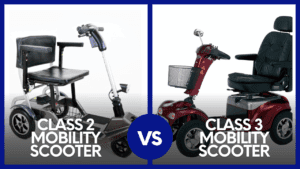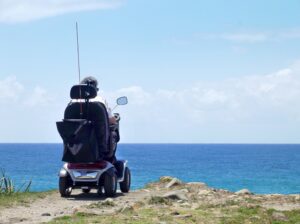What you need to know:
Speed & Usage: Class 2 scooters reach 4mph and are for pavement use only, while Class 3 mobility scooters can travel 8mph on roads plus pavements.
Registration: Class 2 models need no registration, but Class 3 mobility scooter registration with the DVLA is mandatory.
Cost: Class 2 typically costs £800-2,500, Class 3 ranges from £2,000-6,000+.
Best For: Choose Class 2 for shopping and indoor use, Class 3 for longer journeys and main transport.
Quick Decision: Select Class 2 for local trips and easy transport. Choose Class 3 if you need to travel on roads or cover longer distances regularly.

A class 2 mobility scooter vs a class 3 mobility scooter
What is the difference between a Class 2 and Class 3 mobility scooter? This is one of the most common questions we hear, and understanding these differences is crucial for making the right choice. The decision isn’t just about comfort, it’s about legal requirements, practical implications, and finding the perfect match for your lifestyle.
Many people find the rules and options confusing, especially when faced with terms like “DVLA registration” and “road-legal requirements.” This comprehensive guide explains everything you need to know about class 2 and class 3 mobility scooters, helping you make an informed decision that will enhance your independence and quality of life.
What Is the Difference Between a Class 2 and Class 3 Mobility Scooter?
Understanding the fundamental differences between these two classes is essential for making the right choice for your mobility needs.
Class 2 Mobility Scooter Features
A class 2 mobility scooter is designed specifically for pavement and indoor use. These compact scooters have a maximum speed of 4mph, similar to a brisk walking pace, making them perfect for navigating shopping centres, residential areas, and indoor spaces.
The key advantage of choosing a class 2 mobility scooter is portability. Most models are lightweight, typically weighing between 50-80kg, and many fold or disassemble for easy transport in a car boot. This makes them ideal for people who want to take their scooter on holiday or days out with family.
Class 2 scooters require no DVLA registration, have no age restrictions, and are generally more affordable than their Class 3 counterparts.
| Class 2 Feature | Benefit | Best For |
| Tight turning radius | Easy indoor navigation | Shopping centres, homes |
| Lightweight batteries | Convenient charging anywhere | Users with limited strength |
| Compact design | Fits small storage spaces | Limited home storage |
| Easy disassembly | Car boot transport | Holidays, family visits |
Class 3 Mobility Scooter Specifications
A class 3 mobility scooter, often called a “road scooter,” offers much greater versatility. These scooters can travel at speeds up to 8mph on roads, though they must reduce to 4mph when used on pavements. This higher speed capability allows them to be used legally on roads as well as pavements, making them ideal for longer journeys and covering greater distances.
Class 3 scooters are larger and more robust than Class 2 models, typically weighing between 80-150kg.
| Safety Equipment | Purpose | Legal Requirement |
| Headlights & rear lights | Visibility in poor conditions | Yes – must be working |
| Indicators | Signal turning intentions | Yes – for road safety |
| Rear-view mirrors | Monitor traffic behind | Yes – legal requirement |
| Horn | Alert other road users | Yes – audible warning |
| Enhanced suspension | Comfort on longer journeys | Recommended for comfort |
However, class 3 mobility scooter registration with the DVLA is mandatory, and there’s a minimum age requirement of 14 years. These scooters are generally not suitable for car transport due to their size and weight.
Class 3 Mobility Scooter Registration Requirements
If you choose a class 3 mobility scooter, DVLA registration is a legal requirement, not an option. You must register your scooter using Form V55/4 for new scooters or Form V55/5 for used models.
The good news is that while registration is mandatory, there’s no road tax, MOT requirement, or driving licence needed. However, you should have a basic understanding of the Highway Code to use your scooter safely on roads.
Class 3 mobility scooter registration ensures legal compliance for road use, proper identification if your scooter is stolen, and smooth insurance claims processing if you choose to insure your scooter. The registration process is straightforward and free, but it must be completed before using your scooter on public roads.
Related: Do you have to register a mobility scooter with the DVLA?
Class 3 Mobility Scooter Rules and Road Use
When using a class 3 mobility scooter on roads, specific rules must be followed to ensure safety and legal compliance. The maximum speed limit is 8mph on roads, but you must reduce to 4mph when using pavements. You must follow the direction of traffic flow, use lights during poor visibility or at night, and obey all traffic signals and road signs.
Class 3 mobility scooter rules also specify that these scooters cannot be used on motorways, in bus lanes, or cycle-only lanes. Users must give way to pedestrians when on pavements and should be considerate to other road users at all times.
The road safety equipment fitted to Class 3 scooters isn’t just for show, it’s a legal requirement. The headlights, rear lights, indicators, horn, and rear-view mirrors must all be in working order and used appropriately when travelling on roads.
Related: Benefits of using a mobility scooter
Can Anyone Use a Class 3 Mobility Scooter?
Can anyone use a class 3 mobility scooter? Not quite. There are specific eligibility requirements that must be met. The minimum age is 14 years, and users must demonstrate the ability to operate the scooter safely and understand basic road safety principles.
Physical capability is also important. Users should be able to reach and operate all controls comfortably, have adequate vision to see traffic and pedestrians clearly, and possess the cognitive ability to make quick safety decisions when sharing road space with vehicles.
Medical considerations may influence suitability for heavier Class 3 models. If you have conditions affecting your balance, reaction time, or vision, it’s advisable to consult with healthcare professionals before choosing a class 3 mobility scooter. Some users may benefit from starting with supervised practice in quiet areas before venturing onto busier roads.
Class 3 Mobility Scooter Insurance Considerations
While class 3 mobility scooter insurance isn’t legally required, it’s strongly recommended given that these scooters share road space with vehicles. Insurance typically costs between £150-300 annually and provides valuable protection including third-party liability coverage, theft protection, and damage coverage.
Third-party liability is particularly important because if your scooter is involved in an accident that damages property or injures someone, you could be held financially responsible. Comprehensive class 3 mobility scooter insurance policies often include breakdown assistance, which can be invaluable if your scooter develops a fault while you’re away from home.
When considering insurance options, look for policies that understand the specific needs of mobility scooter users. Some insurers offer additional benefits such as replacement scooter provision while yours is being repaired, or coverage for accessories and modifications.
Real-World User Experiences
Understanding how these scooters perform in daily life helps inform your choice. Class 2 users often appreciate the convenience: “My lightweight scooter has been perfect for shopping trips. I can easily fold it into my daughter’s car boot for days out,” explains Margaret, a regular user.
Class 3 scooter owners value the independence: “Since getting my Class 3 scooter, I can travel the 3 miles to town and return home safely on roads where there’s no pavement,” shares Jennifer, who relies on her scooter as primary transport.

Cost Comparison and Budgeting
Understanding the full financial picture helps make informed decisions about mobility scooter investment.
| Cost Factor | Class 2 Range | Class 3 Range | Notes |
| Purchase Price | £800-2,500 | £2,000-6,000+ | Basic to premium models |
| Annual Servicing | £55-80 | £55-80 | Same for both classes |
| Insurance | Optional | £150-300 | Recommended for Class 3 |
| Battery Replacement | £100-300 | £100-300 | Every 2-3 years |
| DVLA Registration | Free (not required) | Free (required) | One-time process |
Beyond the initial purchase price, consider ongoing costs and funding options. NHS or Social Services may provide basic models for medical needs, insurance claims sometimes cover mobility aids, the Motability Scheme serves eligible customers, and hire-to-buy arrangements spread costs over time.
Related: Why Hire Mobility Equipment
Which Scooter Class Suits Your Lifestyle?
Consider a Class 2 if you primarily make local journeys under 2 miles, need indoor manoeuvrability for shopping or home use, want easy transport in car boots for holidays, have limited storage space, or only need occasional mobility assistance.
A class 3 mobility scooter suits you if you regularly travel 3+ miles, need road access for areas without pavements, want all-day comfort for extended use, feel confident with road rules, have dedicated storage space, or require it as your main transport method.
Scenario-Based Decision Making
For weekly grocery shopping, both classes work well, but a class 2 mobility scooter manoeuvres more easily indoors. Longer journeys over 5 miles require a class 3 mobility scooter for the necessary speed and range.
Holiday transport favours Class 2 models due to portability, while daily commuting over 3 miles needs a class 3 mobility scooter for road-legal status. Mixed road and pavement use requires Class 3, as Class 2 models are pavement-restricted.
Related: Can you hire mobility scooters to take on holiday
Maintenance and Long-Term Care
Both scooter classes require regular maintenance for safe operation. Weekly tasks include battery charging and visual safety checks. Monthly maintenance involves checking tyre pressure and cleaning. Annual professional servicing costs £55-80 for both types.
Battery care is crucial – always charge after use, avoid full discharge, and expect replacement every 2-3 years. Proper maintenance significantly extends battery lifespan and maintains your scooter’s performance.
Trial and Hire Options
Before purchasing, consider hiring different models to test suitability. Short-term hire works well for recovery periods, trial use before buying, or holiday requirements.
Hiring offers try-before-you-buy opportunities, no large upfront investment, professional delivery and setup, and flexibility to change models. The experience often reveals practical considerations like doorway fit, control comfort, and battery life matching your daily routines.
Making Your Final Decision
When deciding between class 2 and class 3 mobility scooters, start by honestly assessing your mobility needs, typical journey distances, and lifestyle requirements. Consider whether you need road access, how important portability is to you, and your comfort level with road rules and traffic.
Budget considerations should include not just the purchase price but ongoing costs such as insurance, maintenance, and storage. Think about your living situation too, do you have space for a larger Class 3 scooter, or would a compact Class 2 model be more practical?
Professional assessment can identify factors you might not have considered. Our mobility experts can evaluate your specific needs, demonstrate different models, and provide guidance on which class of scooter best suits your circumstances.
Frequently Asked Questions
Do I need insurance for a class 3 mobility scooter?
Class 3 mobility scooter insurance isn’t legally required, but it’s strongly recommended due to road use. Coverage typically costs £150-300 annually and includes third-party liability, theft, and damage protection.
Can I drive a class 3 mobility scooter on the pavement?
Yes, but you must reduce speed to 4mph when on pavements and always give way to pedestrians.
How do I complete class 3 mobility scooter registration?
Use form V55/4 for new scooters or V55/5 for used models. There’s no fee, road tax, or MOT required.
What’s the minimum age for a class 3 mobility scooter?
14 years old, though users should demonstrate safe operation ability and understand basic road rules.
Can I take my scooter on public transport?
Most buses and trains accept class 2 mobility scooters due to their compact size. Class 3 scooters are typically too large for public transport.
Conclusion: Your Path to Greater Independence
Choosing between a class 2 mobility scooter and a class 3 mobility scooter is ultimately about matching the right tool to your lifestyle needs. Both classes offer pathways to greater independence, but they serve different purposes and user requirements.
Remember that a class 2 mobility scooter excels at local trips, indoor use, and easy transport, while a class 3 mobility scooter provides the freedom for longer journeys and road travel with additional legal responsibilities. The key is honest self-assessment of your needs, circumstances, and comfort level with different features and requirements.
Ready to Find Your Perfect Scooter?
At Direct Mobility, we understand that choosing between class 2 and class 3 mobility scooters is an important decision that affects your daily independence and quality of life. Our experienced team provides personalised guidance, arranges trial periods, and ensures you find the perfect solution for your specific needs.
Whether you need a class 2 mobility scooter for convenient local travel or a class 3 mobility scooter for longer journeys and road use, we offer comprehensive support including professional delivery, setup throughout London and the home counties, and ongoing maintenance services.
Contact us today to discuss your mobility needs and discover how the right scooter can transform your independence. Your mobility matters to us, and we’re here to guide you to the perfect solution.

